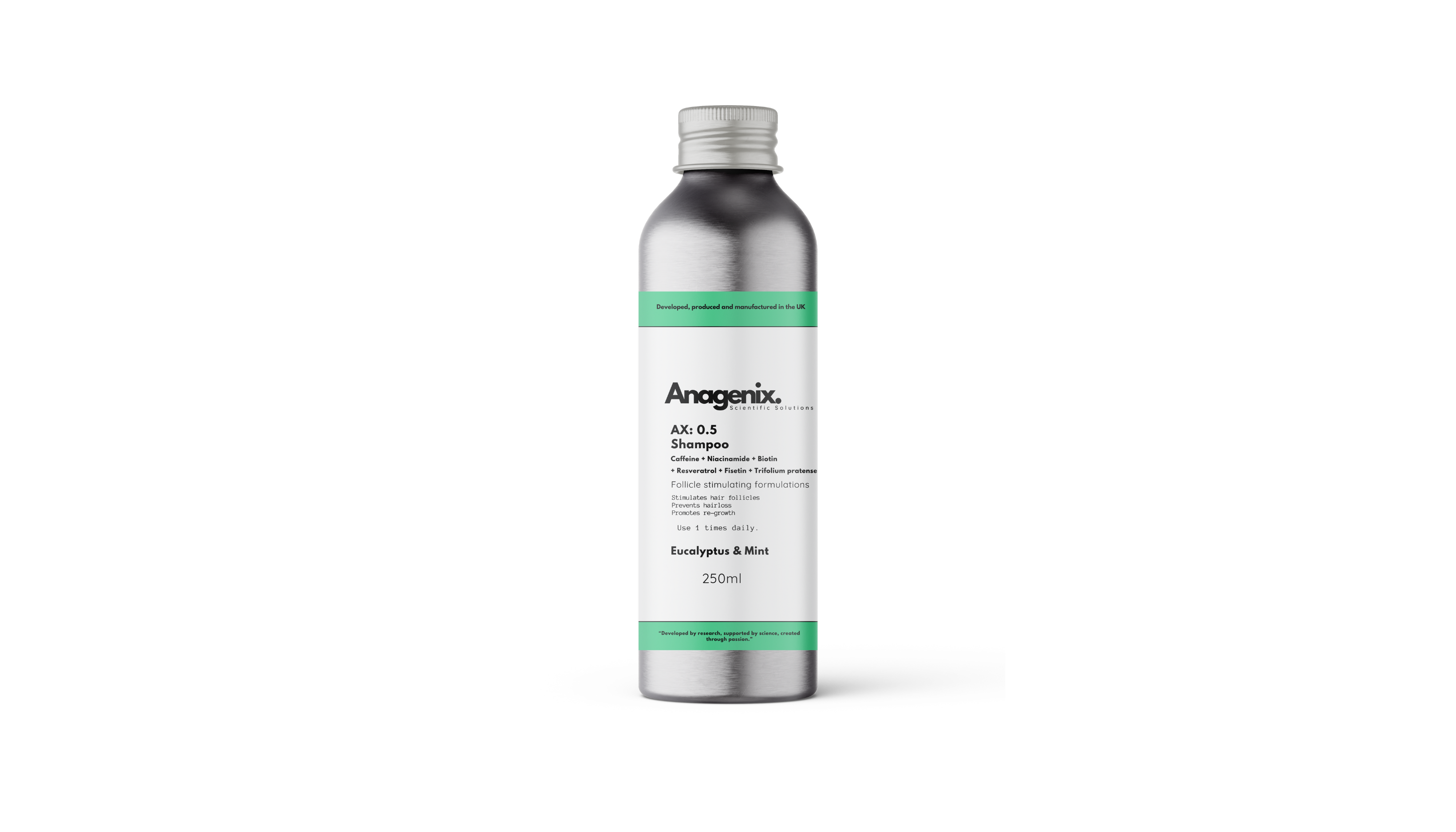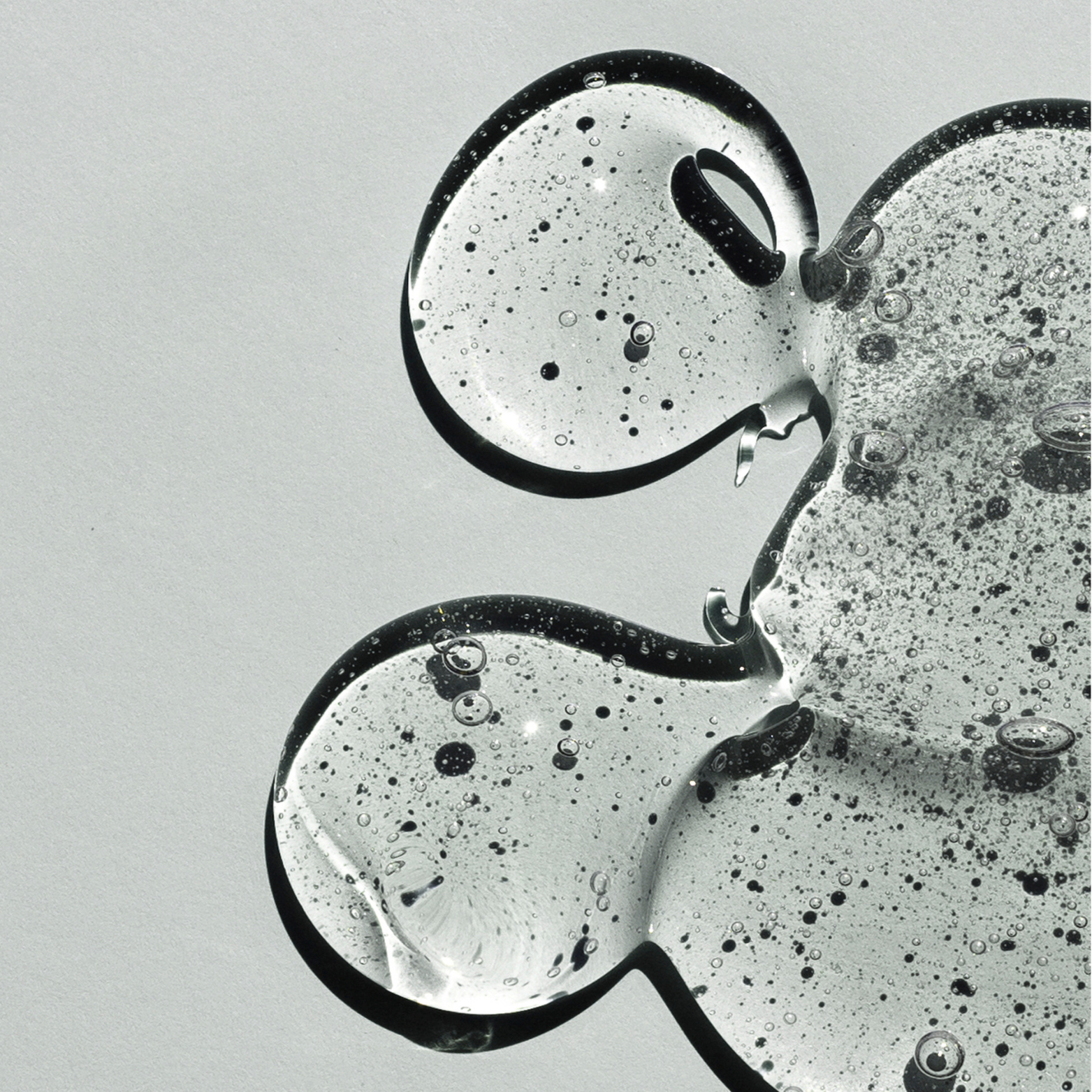
Active Ingredients

Caffeine
Caffeine, a methylxanthine compound, has garnered attention for its potential efficacy in treating hair loss. Scientific investigations propose that caffeine, when topically applied, may exert positive effects on hair health through multiple mechanisms. Primarily, caffeine is known to inhibit phosphodiesterase enzymes, leading to elevated levels of cyclic adenosine monophosphate (cAMP) within hair follicles. This increase in cAMP has been associated with the stimulation of hair keratinocyte proliferation, extending the duration of the anagen (growth) phase. Furthermore, caffeine's vasoactive properties promote enhanced blood circulation when applied to the scalp, facilitating improved nutrient and oxygen delivery to hair follicles. As a result, caffeine emerges as a compelling candidate for inclusion in hair care formulations,
Resveratrol
Resveratrol, a polyphenolic compound found in various plants, has garnered significant attention for its potential therapeutic effects on hair loss and regrowth. Scientific evidence suggests that Resveratrol exerts its beneficial effects through multiple mechanisms.
Firstly, Resveratrol demonstrates potent antioxidant properties, effectively scavenging free radicals and reducing oxidative stress within the scalp microenvironment. By mitigating oxidative damage to hair follicles, Resveratrol helps preserve follicular integrity and promotes a conducive environment for healthy hair growth.
Furthermore, Resveratrol exhibits anti-inflammatory properties, modulating key inflammatory pathways implicated in hair loss conditions such as alopecia. By attenuating chronic inflammation in the scalp, Resveratrol may mitigate the inflammatory cascade that contributes to follicular miniaturisation and subsequent hair thinning.
Moreover, Resveratrol is known to interact with molecular targets involved in regulating hair growth cycles. Studies have shown that Resveratrol can activate signalling pathways associated with hair follicle proliferation, differentiation, and survival. By promoting follicular proliferation and prolonging the anagen phase of the hair growth cycle, Resveratrol may enhance hair density and thickness.
Additionally, Resveratrol exhibits potential anti-androgenic effects, inhibiting the activity of 5-alpha-reductase enzymes responsible for converting testosterone into dihydrotestosterone (DHT), a hormone implicated in androgenic alopecia. By modulating androgen signalling pathways, Resveratrol may mitigate the deleterious effects of DHT on hair follicles and follicular miniaturisation.
Overall, the multifaceted properties of Resveratrol make it a promising candidate for addressing hair loss and promoting hair regrowth and this is why we have included it in this formulation.
Fesitin
Fisetin, a flavonoid commonly found in fruits and vegetables, has emerged as a promising compound with potential benefits for addressing hair loss and promoting hair regrowth. Scientific investigations have unveiled several mechanisms through which fisetin may exert its therapeutic effects on hair health.
Firstly, fisetin demonstrates robust antioxidant properties, effectively scavenging reactive oxygen species (ROS) and mitigating oxidative stress within the scalp microenvironment. By reducing oxidative damage to hair follicles, fisetin helps preserve follicular integrity and create a favorable milieu for optimal hair growth.
Moreover, fisetin exhibits potent anti-inflammatory effects by modulating key inflammatory pathways implicated in hair loss conditions such as alopecia. By attenuating chronic inflammation in the scalp, fisetin may alleviate the inflammatory cascade that contributes to follicular miniaturization and subsequent hair thinning.
Furthermore, fisetin interacts with molecular targets involved in regulating hair growth cycles. Studies have shown that fisetin can stimulate the proliferation of hair follicle cells, prolong the anagen (growth) phase of the hair cycle, and promote hair follicle regeneration. These effects contribute to enhanced hair density, thickness, and overall hair health.
Additionally, fisetin may possess anti-androgenic properties, inhibiting the activity of 5-alpha-reductase enzymes responsible for converting testosterone into dihydrotestosterone (DHT), a hormone implicated in androgenetic alopecia. By modulating androgen signaling pathways, fisetin may mitigate the deleterious effects of DHT on hair follicles and follicular miniaturization.
In conclusion, the multifaceted properties of fisetin make it a promising natural compound for addressing hair loss and promoting hair regrowth. However, further clinical research is warranted to elucidate the optimal dosing, formulation, and long-term efficacy of fisetin-based interventions for hair health optimization.
\
Niacinamide
Niacinamide, also known as vitamin B3, has been studied for its potential positive effects on promoting hair regrowth and reducing hair loss. The biological activities of niacinamide that contribute to its efficacy in this context involve its role as a precursor to nicotinamide adenine dinucleotide (NAD+), a critical coenzyme involved in various cellular processes.
Niacinamide's impact on cellular metabolism is of particular relevance to hair follicle function. By enhancing cellular energy production through the NAD+ pathway, niacinamide supports the energetic demands of actively growing hair follicles, potentially extending the duration of the anagen (growth) phase and optimizing the overall hair growth cycle.
Moreover, niacinamide exhibits anti-inflammatory properties, which may be pivotal in addressing conditions associated with hair loss. Inflammation within the scalp, whether due to environmental factors or underlying conditions, can contribute to hair follicle damage and subsequent hair loss. Niacinamide's ability to modulate inflammatory responses may, therefore, play a role in maintaining a conducive environment for hair regrowth.
Additionally, niacinamide has been suggested to contribute to improved blood circulation. Enhanced blood flow to the scalp can support the delivery of essential nutrients and oxygen to the hair follicles, promoting their health and functionality.
While the body of scientific evidence supporting niacinamide's specific role in hair regrowth is still evolving, studies and research indicate its potential as a valuable component in formulations aimed at reducing hair loss and promoting overall hair health.
Trifolium Pratense
Trifolium pratense is currently under scrutiny for its potential beneficial impact on hair loss. This botanical entity is enriched with isoflavones, notably formononetin and biochanin A, which exhibit estrogenic activity and are implicated in modulating hormonal pathways. These isoflavones, through their interactions with key molecular players, may contribute to the preservation of hair follicles and stimulation of hair regrowth. Moreover, red clover's anti-inflammatory and antioxidant attributes are posited to mitigate oxidative stress and inflammatory cascades that are implicated in hair loss. While initial investigations suggest a promising role for red clover in addressing hair loss, further rigorous studies are essential to validate and delineate the mechanisms underlying its potential therapeutic efficacy in this context. Given the promising reports so far Anagenix chose to inlude this in their AX:01 formulation.
Biotin
Biotin, a water-soluble B-vitamin, has garnered attention for its potential role in promoting hair health and combating hair loss. Scientific studies suggest that biotin may support the production of keratin, a key structural protein in hair, by aiding in the metabolism of amino acids necessary for its synthesis. Additionally, biotin may contribute to the maintenance of a healthy scalp environment, which is crucial for optimal hair growth. While research on the specific effects of biotin supplementation on hair loss is ongoing, some individuals experiencing hair thinning or brittleness may benefit from incorporating biotin into their daily routine as part of a comprehensive approach to hair care.
